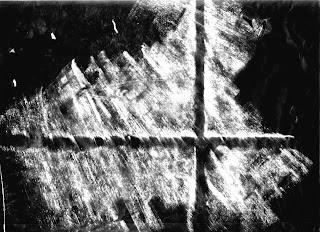Following on from Ian Breakwell and Simon Pope, I am aware of how unaware we are of our surroundings. For example, some time ago I tried to draw from memory, my walk to university, but only drawing above the ground floor of the buildings I passed. This very difficult exercise highlighted how we never notice upper storeys of buildings, rarely looking above or below our eye-level and generally how unobservant we are. I am trying to incorporate aspects of the built environment in my work; linking my printmaking with my work as an architect. It has lead me to research artists who use or record elements of the environment in their work.
I've looked at the prints of Tom Phillips who on his journey to work photographed every stop cock he passed in the pavement, and on the way home photographed those on the other side of the street. He transferred these to form a large etching - Canto XXXII, 1983, which documents a specific observation on his journey in pictorial form, recording elements which would normally be of little significance.
Continuing my thoughts on highlighting the unremarkable, I'm investigating accidents and interruptions, for example imperfections in building materials that are not usually noticed. Performing charcoal rubbings of surfaces brings up scratches and indentations that are usually overlooked and contrast with architectural precision required in building. By examining say floors, walls, ceilings of my house and outside, I could build up a new language of the environment, removed from the usual plans, sections, elevations - a record of what you would not usually describe.
Shown below are the "Frottages" carried out with charcoal on a roll of specialist architectural detail paper (the medium itself being significant). Not only are imperfections shown up, but also the direction and speed of the work has an influence on the images.
I've looked at the prints of Tom Phillips who on his journey to work photographed every stop cock he passed in the pavement, and on the way home photographed those on the other side of the street. He transferred these to form a large etching - Canto XXXII, 1983, which documents a specific observation on his journey in pictorial form, recording elements which would normally be of little significance.
Continuing my thoughts on highlighting the unremarkable, I'm investigating accidents and interruptions, for example imperfections in building materials that are not usually noticed. Performing charcoal rubbings of surfaces brings up scratches and indentations that are usually overlooked and contrast with architectural precision required in building. By examining say floors, walls, ceilings of my house and outside, I could build up a new language of the environment, removed from the usual plans, sections, elevations - a record of what you would not usually describe.
Shown below are the "Frottages" carried out with charcoal on a roll of specialist architectural detail paper (the medium itself being significant). Not only are imperfections shown up, but also the direction and speed of the work has an influence on the images.
These rubbings were scanned and printed, and some were reversed in photoshop:
Max Ernst is the obvious artist to reference for rubbings or "Frottage", but also the Boyle Family use architectural materials in their work. However, The Boyle Family use casts of actual materials they are describing, whereas mine are transformed onto paper, by rubbing and then manipulated in photoshop and also transformed by the etching process. The transformation through several processes continues my work on process itself. These images not only enhance the imperfections described before, but also continue the "ghost" theme; they describe something which is no longer there; a memory.
I took one of the reversed images of a rubbing of the hall floor, and used the photocopy etching method described in week 2 to transfer the image onto a metal plate (ie: soak the photocopy image for a couple of minutes; place on worktop and dab on oil based ink, mixed with plate oil. Run through the press onto a degreased etching plate. Place in the aquatint box. Use the ink as acid resist and etch for 30 seconds - any longer and the ink would have been bitten away.)
I produced two prints, the first in black, and the second in yellow and black, blended at the edges giving a burnt out look.
This process has resulted in images which are more haunting than before, floating, bearing only traces or memories of the original substance from which they were taken from.
They are reminiscent of Rachel Whiteread's "Study for (Blue) Floor" - partly because of the subject matter (floor) and the diagonal in the composition, but also because she draws only part of the floor, which emerges from the background. She has hand drawn and painted this work onto graph paper - (again a medium used by architects; mine originated as a drawing on architectural detail paper) - and it is this freely drawn nature that contrasts with the precision of the paper.















Once again the grid (now graph paper, but back then the weird photograph of your cutting board with the grid lines all distorted by the camera lens) as background...
ReplyDeleteWorth revisiting. Especially that violent blue and the act of cutting out and the implied collage. A making special, a making your own - and not only using impression.
"journey to work" brought Bill Anastasi's drawings to mind and the Wandering the City part of the great Subversive Spaces show that toured the country three years ago.